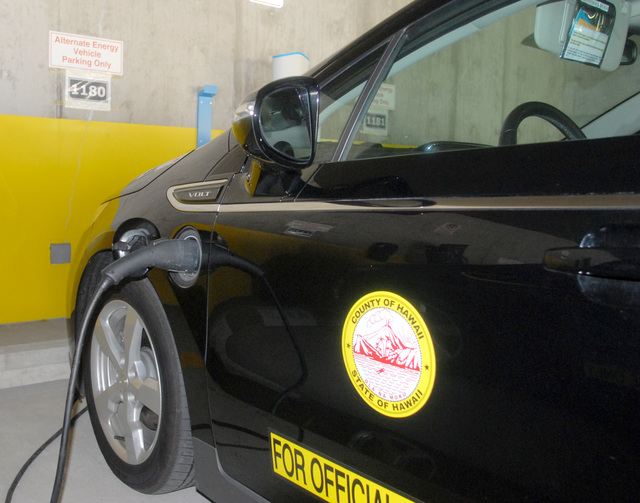Electric vehicle owners will have another place to plug in by the end of the year. ADVERTISING Electric vehicle owners will have another place to plug in by the end of the year. And they can pay their taxes while
Electric vehicle owners will have another place to plug in by the end of the year.
And they can pay their taxes while they’re at it.
As early as Sept. 8, a contractor will begin installing four electric vehicle charging stations, split between Hawaii County’s main building on Aupuni Street in Hilo and what’s known as the Aupuni Center across the street.
The stations are scheduled to be complete Nov. 6 and cost $117,000 all together, according to the county Department of Public Works.
Will Rolston, county energy coordinator, said the charging stations are being built to serve the county’s small hybrid vehicle fleet, though they will be available to the public for free.
The county is installing what’s known as level II stations, which can take a couple hours to reach a full charge. So, that might not serve any electric vehicle owners who live far from town.
But it should work just fine for county workers, Rolston said.
The county has five Chevrolet Volt hybrid cars based at the West Hawaii Civic Center, where charging stations were installed in February 2012.
Starting from Kailua-Kona, the car’s batteries are able to get them to the start of Saddle Road without using a drop of fuel, Rolston said. By the time they get into Hilo, the batteries are about halfway charged with the help of the car’s regenerative braking system.
Using charging stations in Hilo will help further reduce the use of gasoline on the return trip and could help expand the county’s use of hybrids and electric cars in the future, Rolston said.
But, unlike the charging stations in Kona, these won’t be entirely carbon neutral.
The West Hawaii Civic Center’s charging stations are powered by solar panels, which also feed a storage battery for use during the evening.
The main county building in Hilo also has solar panels but lacks a storage system. The Aupuni Center, on the other hand, is powered entirely by the grid.
The cost of powering up with electricity from the grid would probably be similar to filling up at the gas station, Rolston said.
Use of the solar panels in Kona equates to buying gas at $2 a gallon, he said. The county buys the power from the installer at 20 cents per kilowatt hour.
“If an all (electric) mode, it’s a real deal,” Rolston said.
He said it takes the county about 1 1/2 years to make up the higher cost of the cars, which the county purchased for $45,000 each.
Rolston said the county should consider buying more as prices come down, the technology improves and the infrastructure to support them grows.
Email Tom Callis at tcallis@hawaiitribune-herald.com.



